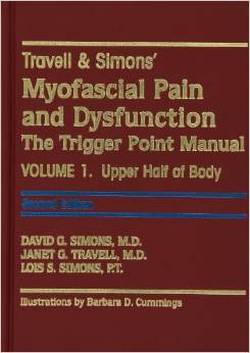 Trigger points are tender taut bands in muscle or fascia which, when pressed, often elicit a "jump" or "ouch" response from the patient, and may produce a predictable referred pain pattern to other areas nearby. Some people call them "palpable pain points". They may be active (i.e. produce pain even when not pressed) or latent, (producing tenderness when pressed but not otherwise). They may be primary - the original site of the injury, or secondary , due to the muscle having to over-work because of lax ligaments, for instance. There is a tendency for new tender points to form in the same muscle or neighbouring muscles. Trigger point pain may mimic other conditions because of referred pain. Some examples: Trigger points in the sternocleidomastoid muscle (the long strap-like muscle that stretches from behind your ear down to the collar bone and turns your head to the other side) can cause pain in the upper teeth leading to unnecessary dental work being done. Trigger points in the pectoralis major can mimic a heart attack or produce breast pain. Trigger points can form as a result of injury (such as a muscle strain or fall), or form over-use, posture or poor ergonomics, or when the muscle has to compensate for other structures which are not functioning adequately. Trigger points (known as ah shi points) were treated with acupuncture long before western physicians began treating them in the 1940s. Drs. Travell and Simons produced a two volume encyclopedic description of different muscles and their pain patterns and how to treat them with a combination of injections, stretches and cool sprays. Most trigger point charts, pictures and books are based to a greater or lesser degree on those two volumes. Trigger Point Treatment Options: 1. ischemic compression - this involves identifying a tender point, pressing on it with a thumb, finger, ball or other object (such as a theracane) firmly enough to cause discomfort but not severe pain. One then stretches the muscle along its long axis, takes in a deep breath and presses a little firmer. An excellent explanation of this technique can be found on Dr Kuttner's website. This is not the method we use but it is effective and can be a useful form of self-therapy. Dr Kuttner's site is very informative and he has inexpensive resources available there. 2. Various myofascial release techniques have been used by physiotherapists and massage therapists and are often effective but may aggravate the pain if administered too vigorously, or if the pain is due to inflamed sensory nerves rather than primarily a muscular problem. 3. Our preferred non-needle technique is a group of simple, painless, and safe procedures collectively known as the "Pain Neutralization Technique", which, when effective, works nearly instantly. 4. Acupuncture or "dry-needling" has been used for centuries to treat trigger points. Modern versions - using a very fine, single-use, pre-packaged, sterile, disposable, solid (not hypodermic) acupuncture needle - include Dr. Chan Gunn's Intramuscular Stimulation (IMS) and Dr Cynthia Gokavi's adaptation, the Gokavi Transverse Technique. IMS or dry-needling are often offered by physiotherapists and pain clinics and do not involve any medications. 5.Trigger points can also be injected with a hypodermic needle and syringe. With injections one has both the direct needle effect and the ingredient effect. The needle itself does much of the work in releasing the tight band. Drs. Travell and Simon pioneered the use of local anesthetic injections into trigger points using Procaine. Today Lidocaine is usually the local anesthetic of choice; some physicians mix this with longer-acting local anesthetic such as Bupivicaine (Marcaine) and may add some steroid (cortisone-like medication). There is no evidence that steroids are helpful for this and may be harmful. Longer-acting anaesthetics are said to reduce the post-injection soreness from the needle which some people feel later, but carry greater risk if used in excess doses, or if they get into the bloodstream too quickly. Some alternative practitioners add herbs, vitamins and homeopathic remedies to their injections but we do not advocate this. Some physicians use normal saline without anaesthetic for trigger point injections. This avoids the rare risks associated with the medications but may leave a little more soreness the next day. Dr Greg Siren (at the Myo Clinic and Changepain) uses this method very effectively and has generously taught this to other physicians in BC. A study was published in Korea in 1997 comparing three groups of patients with trigger point injections, one group with normal saline, one group with local anesthetic, and another group with 5% dextrose (D5W). Each method was effective but, of these, the local anesthetic group did better than saline, and D5W performed the best of the three. This is possibly because of the known benefit of dextrose in relieving neurogenic pain. This is only one study and if repeated elsewhere might produce a different outcome. Comments are closed.
|
AuthorDavid is a fan of books and no doubt will be sharing some good reads here. Archives
February 2024
Categories
All
|
 RSS Feed
RSS Feed